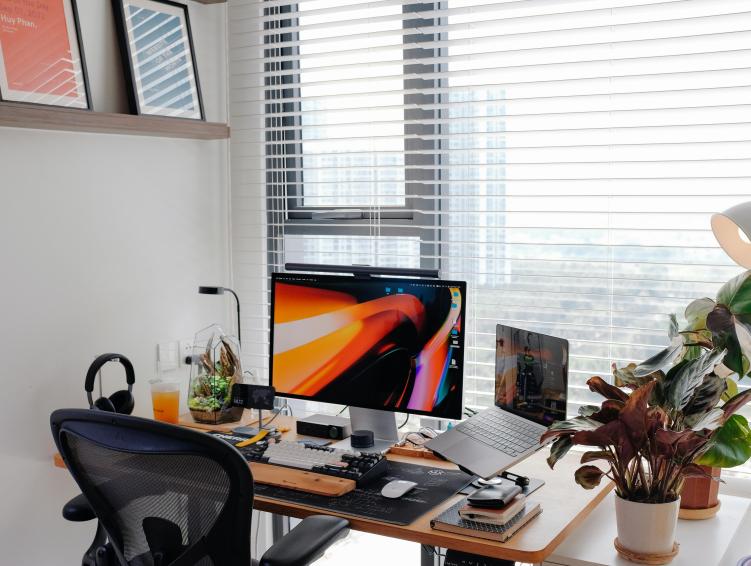As screens dominate our daily routines, the importance of protecting our eyes has never been more pressing. Digital devices, from smartphones to laptops, emit blue light, which can contribute to various eye problems and discomfort. Understanding the effects of blue light and how to mitigate its impact is crucial for maintaining good eye health. With the average person spending over seven hours daily in front of a screen, awareness of blue light exposure has never been more critical. Taking small but consistent steps to protect your vision can lead to long-term health benefits.
What is Blue Light?
Blue light is part of the visible light spectrum, ranging from about 380 to 500 nanometers. It has a short wavelength and produces higher amounts of energy compared to other colors in the light spectrum. There are two main sources of blue light: natural and artificial. Natural blue light comes from the sun, while artificial sources include computer screens, smartphones, tablets, and LED lighting. Research shows that exposure to blue light is increasing, given our reliance on technology for work and leisure. In moderate amounts, blue light can help regulate our sleep-wake cycle, mood, and alertness. Excessive artificial exposure, especially during nighttime, can upset the body’s biological balance.
The Effects of Blue Light on Eye Health
Prolonged exposure to blue light can lead to digital eye strain, also known as computer vision syndrome. Symptoms include blurry vision, dry eyes, headaches, and neck pain. A 2016 study found that 60% of adults report experiencing digital eye strain, with those who spend more than six hours a day on digital devices being at a higher risk.
There are concerns about the long-term effects of blue light exposure. Some research links high-energy blue light to potential retinal damage and an increased risk of age-related macular degeneration (AMD). Although more studies are needed to fully understand these risks, protecting your eyes from excessive blue light is wise.
Common Myths About Blue Light
Several misconceptions exist regarding blue light and eye health. One prevalent myth is that only people who wear glasses need to be concerned about blue light. In reality, everyone who uses digital devices should consider protective measures. Another myth suggests that blue light only affects individuals with pre-existing eye conditions. While those individuals may be more vulnerable, even healthy eyes can experience strain and discomfort from blue light exposure.
Overall, educating yourself about these myths can help you take informed steps toward protecting your eye health.
Strategies for Reducing Blue Light Exposure
There are various ways to minimize blue light exposure in your daily life. Reducing screen time, utilizing blue light filters, and adhering to the 20-20-20 rule are some effective methods. The 20-20-20 rule suggests that for every 20 minutes spent on a screen, you should take a 20-second break and focus on an object at least 20 feet away. Doing this can significantly reduce eye strain over time.
Another practical approach entails adjusting your environment. Ensuring adequate lighting while using screens, avoiding glare from windows or overhead lights, and using softer lighting can help create a more comfortable viewing experience. Incorporating these techniques into your routine can lead to noticeable improvements in visual comfort and focus. Over time, reduced exposure can lessen reliance on eye drops or artificial tears.
The Role of Blue Light Glasses
Many individuals are turning to blue light glasses as a precautionary measure. These glasses filter out a portion of blue light emitted from screens, potentially reducing glare and strain. While the efficacy of blue light glasses remains a topic of debate, many users report positive experiences and feel more comfortable while using their devices. As explained by experts from blockbluelight.com, choosing quality blue light glasses ensures you benefit from proper protection. Look for options that combine blue light-blocking technology with a comfortable fit and style that you will wear consistently.
The Impact of Sleeping Habits on Eye Health
Sleep plays a crucial role in overall health, including eye health. Studies indicate that disrupted sleep can exacerbate the effects of digital eye strain. Blue light exposure in the evening can interfere with the body’s natural circadian rhythm, making it harder to fall asleep and stay asleep. To protect your eyes and support proper rest, limit digital device use at least one hour before bedtime.
Consistently poor sleep can lead to dry eyes, twitching, and reduced tear production. Maintaining good sleep hygiene supports eye health and mental clarity and mood.
Investing time in a relaxing evening routine, such as reading a physical book or meditation, can help improve sleep quality and promote long-term eye comfort.
Dimming lights in the evening and switching to warmer screen tones help ease the transition to sleep. When practiced regularly, these habits create a healthy rhythm that protects both your eyes and your sleep quality.
Protecting your eyes from blue light exposure is increasingly relevant as digital device usage rises. By understanding the effects of blue light, dispelling myths, and adopting practical strategies, you can maintain optimal eye health. Using measures like blue light glasses can provide protection while enhancing your screen viewing experience. Prioritize your eye health, and become proactive in addressing the factors that contribute to digital eye strain.


As screens dominate our daily routines, the importance of protecting our eyes has never been more pressing. Digital devices, from smartphones to laptops, emit blue light, which can contribute to various eye problems and discomfort. Understanding the effects of blue light and how to mitigate its impact is crucial for maintaining good eye health. With the average person spending over seven hours daily in front of a screen, awareness of blue light exposure has never been more critical. Taking small but consistent steps to protect your vision can lead to long-term health benefits.
What is Blue Light?
Blue light is part of the visible light spectrum, ranging from about 380 to 500 nanometers. It has a short wavelength and produces higher amounts of energy compared to other colors in the light spectrum. There are two main sources of blue light: natural and artificial. Natural blue light comes from the sun, while artificial sources include computer screens, smartphones, tablets, and LED lighting. Research shows that exposure to blue light is increasing, given our reliance on technology for work and leisure. In moderate amounts, blue light can help regulate our sleep-wake cycle, mood, and alertness. Excessive artificial exposure, especially during nighttime, can upset the body’s biological balance.
The Effects of Blue Light on Eye Health
Prolonged exposure to blue light can lead to digital eye strain, also known as computer vision syndrome. Symptoms include blurry vision, dry eyes, headaches, and neck pain. A 2016 study found that 60% of adults report experiencing digital eye strain, with those who spend more than six hours a day on digital devices being at a higher risk.
There are concerns about the long-term effects of blue light exposure. Some research links high-energy blue light to potential retinal damage and an increased risk of age-related macular degeneration (AMD). Although more studies are needed to fully understand these risks, protecting your eyes from excessive blue light is wise.
Common Myths About Blue Light
Several misconceptions exist regarding blue light and eye health. One prevalent myth is that only people who wear glasses need to be concerned about blue light. In reality, everyone who uses digital devices should consider protective measures. Another myth suggests that blue light only affects individuals with pre-existing eye conditions. While those individuals may be more vulnerable, even healthy eyes can experience strain and discomfort from blue light exposure.
Overall, educating yourself about these myths can help you take informed steps toward protecting your eye health.
Strategies for Reducing Blue Light Exposure
There are various ways to minimize blue light exposure in your daily life. Reducing screen time, utilizing blue light filters, and adhering to the 20-20-20 rule are some effective methods. The 20-20-20 rule suggests that for every 20 minutes spent on a screen, you should take a 20-second break and focus on an object at least 20 feet away. Doing this can significantly reduce eye strain over time.
Another practical approach entails adjusting your environment. Ensuring adequate lighting while using screens, avoiding glare from windows or overhead lights, and using softer lighting can help create a more comfortable viewing experience. Incorporating these techniques into your routine can lead to noticeable improvements in visual comfort and focus. Over time, reduced exposure can lessen reliance on eye drops or artificial tears.
The Role of Blue Light Glasses
Many individuals are turning to blue light glasses as a precautionary measure. These glasses filter out a portion of blue light emitted from screens, potentially reducing glare and strain. While the efficacy of blue light glasses remains a topic of debate, many users report positive experiences and feel more comfortable while using their devices. As explained by experts from blockbluelight.com, choosing quality blue light glasses ensures you benefit from proper protection. Look for options that combine blue light-blocking technology with a comfortable fit and style that you will wear consistently.
The Impact of Sleeping Habits on Eye Health
Sleep plays a crucial role in overall health, including eye health. Studies indicate that disrupted sleep can exacerbate the effects of digital eye strain. Blue light exposure in the evening can interfere with the body’s natural circadian rhythm, making it harder to fall asleep and stay asleep. To protect your eyes and support proper rest, limit digital device use at least one hour before bedtime.
Consistently poor sleep can lead to dry eyes, twitching, and reduced tear production. Maintaining good sleep hygiene supports eye health and mental clarity and mood.
Investing time in a relaxing evening routine, such as reading a physical book or meditation, can help improve sleep quality and promote long-term eye comfort.
Dimming lights in the evening and switching to warmer screen tones help ease the transition to sleep. When practiced regularly, these habits create a healthy rhythm that protects both your eyes and your sleep quality.
Protecting your eyes from blue light exposure is increasingly relevant as digital device usage rises. By understanding the effects of blue light, dispelling myths, and adopting practical strategies, you can maintain optimal eye health. Using measures like blue light glasses can provide protection while enhancing your screen viewing experience. Prioritize your eye health, and become proactive in addressing the factors that contribute to digital eye strain.
Related Content: